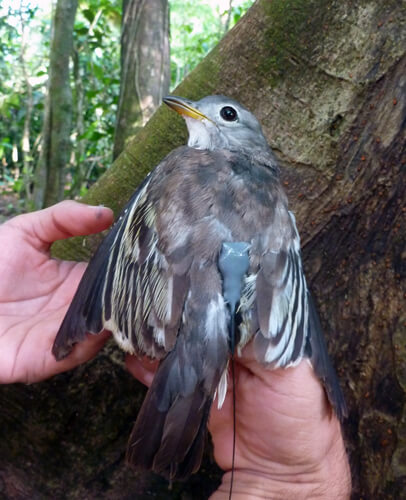Rare Bird Captured for First Time, Fitted With Tracking Device and Released
For Immediate Release Contact:
, 202-234-7181 ext. 210
 |
Yellow-billed Cotinga female. Photo: Karen Leavelle |
(Washington, D.C.,
This rare bird about which relatively little is known is endemic to the Pacific slope mangrove forests of Panama and Costa Rica. Its capture and study is part of a project funded by the Mohammad bin Zayed Foundation and being carried out jointly by ABC and Friends of the OSA (an environmental group that focuses on conservation in the OSA Peninsula, Costa Rica).
“This is a bird that we believe used to exist in large numbers but is now increasingly difficult to even glimpse, much less study. This is an outstanding opportunity to acquire information on this bird and take action to address its habitat needs now before it is too late.” said Andrew Rothman, ABC conservation biologist who oversees ABC programs in Costa Rica.
“Placing a radio transmitter on a rare and endangered species such as the Yellow-billed Cotinga is a tremendous responsibility as well as a great opportunity which will open the door to a wealth of ecological and behavioral information; especially information on its seasonal movements and habitat use, that will guide us in protecting this little known bird,” says Karen Leavelle, who is Friends of the Osa’s Chief Investigator on the project.
The birds were captured in mist nets on
Yellow-billed Cotingas are about the size and shape of a pigeon and are strong flyers. Males are bright white, with yellow bills and perform swooping flight displays to attract females. Despite their efforts at being conspicuous, little remains known about this species due to the lack of scientific research on the species. Much of their former range has been deforested in both Costa Rica and Panama, so the birds are thought to be in decline.
In 2007, ABC and Friends of the Osa began working with local birding guides to monitor birds in the Osa Peninsula and Golfo Dulce region of southern Costa Rica, thought to be the stronghold for the Yellow-billed Cotinga. The two organizations conducted bird counts across the region, with a focus on areas where they might find cotingas.
In 2008 and 2009, adult Yellow-billed Cotingas were found feeding on fruiting trees in most of the areas where healthy forests remained close to mangroves, including the Rincon area. It was there that the first-ever nest was observed, with one nestling, in a mangrove tree (though unfortunately the nest was later predated).
Since then, multiple sightings of adult females accompanied by fledglings have occurred in mangroves and males have been seen displaying in forests far from coastal mangroves though no evidence has been found that females nest there. Therefore, it seems that this is a bird that prefers to nest in mangroves and dine in the forests — requiring both habitats, probably in close proximity, to survive.
The Osa Peninsula of Costa Rica is blessed with a significant number of large national parks, national wetlands, and forest reserves. However, many of the most important places where mangroves and forests meet, where the cotingas appear most abundant, fall within unprotected gaps outside this system of protection.
American Bird Conservancy conserves native birds and their habitats throughout the Americas by safeguarding the rarest species, protecting and restoring habitats, and reducing threats while building capacity of the bird conservation movement. For more information, visit, www.abcbirds.org


















































